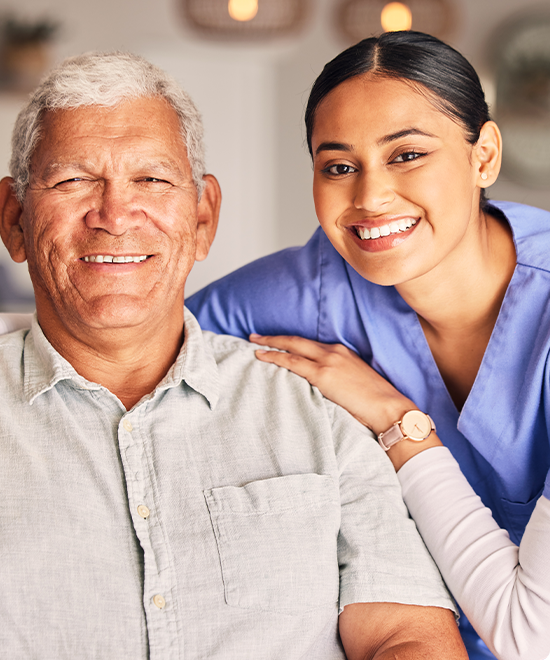This website uses cookies so that we can provide you with the best user experience possible. Cookie information is stored in your browser and performs functions such as recognising you when you return to our website and helping our team to understand which sections of the website you find most interesting and useful.
Home Care In Seattle, WA

They say that your golden years are the best years of your life. For most older Americans, that's how it should be - a time to relax, reflect, and live life in a familiar place. After all, senior citizens in the U.S. have worked tirelessly to build a better economy, serve their communities, and raise families.
However, as seniors grow older, completing daily tasks like showering and enjoying activities such as visiting Smith Tower in Seattle, WA gets harder without someone by their side. Unfortunately, many older Americans aren't able to rely on their adult children for help. The reality in today's world is that family members do not have the skills or time to dedicate to caring for their parents. That's where Always Best Care Senior Services comes in.
Our in-home care services are for people who prefer to stay at home as they grow older but need ongoing care that family or friends cannot provide. More and more older adults prefer to live far away from long-term, institutionalized facilities and closer to the place where they feel most comfortable - their home. Home care in Seattle, WA is a safe, effective way to give your loved ones the care they need when they need it the most.

 Home Care Services
Home Care Services
- Home Care in Seattle, WA
- The Always Best Care Difference
- Types of In-home Care in Seattle, WA
- Benefits of Home Care in Seattle, WA
- Aging in Place: The Preferred Choice for Most Seniors
- Affordable Care Plans
- Compassionate Care. Trusted Caregivers
- Assisted Living Referral Services
- Taking the First Step with Always Best Care
 Service Areas
Service Areas
The Always Best Care Difference
Since 1996, Always Best Care has provided non-medical in-home care for seniors to help them maintain a healthy lifestyle as they get older. We are proud to have helped more than 25,000 seniors maintain higher levels of dignity and respect. We focus on providing seniors with the highest level of in-home care available so that they may live happily and independently.
Unlike some senior care companies, we genuinely want to be included in our clients' lives. We believe that personalized care is always the better option over a "one size fits all" approach. To make sure our senior clients receive the best care possible, we pair them with compassionate caregivers who understand their unique needs. That way, they may provide care accordingly without compromising their wellbeing.
The Always Best Care difference lies in life's little moments - where compassionate care and trustworthy experience come together to help seniors live a fruitful, healthy life. Whether you are an aging adult that can't quite keep up with life's daily tasks or the child of a senior who needs regular in-home services, Always Best Care is here to help.
“Provided quality care for a relative settling back home after a hospital stay. Well managed”
“I am a past client of this provider Excellent caregiving staff. Really communicated well & provided”
“I am a past client of this provider I worked with Joseph and Maimuna after knee”
“I am a past client of this provider Consistently received quick professional responses from the owner”
“Sarah came and met with our grandmother in advance of her return home from the”
“ABC works well with other provider services such as the VA and home RN healthcare”
“Responsive office, qualified care givers.”
“We have a wonderful experience, with ABCSS. The Team and services are the best.”
“The team at Always Best Care is just phenomenal. We've had nothing but amazing service.”
“Cannot say enough good things about Sarah and Always Best Care! After my step dad”
“ABC Senior Services excels in all aspects. This is a group you can rely on”
“Our family had an extremely positive experience with Always Best Care. During a very”
“Our family had an extremely positive experience with Always Best Care. During a very tough”
“After looking far and wide in Seattle, finally I found Always Best Care - what”
“Sarah at Alway Best Care Senior Services is excellent. She is compassionate and understands”
“This company did a fantastic job caring for my father. I highly recommend them for”
“I cannot praise Sarah and her team enough. My husband had a stroke and was”
“I am a current client of this provider I cannot praise Sarah and her team enough.”
“My experience with Always Best Care was phenomenal! I have never experienced an owner, and her”
“I hired Always Best Care (“ABC”) to provide caregivers for my husband, who has Parkinson’s”
“I am a current client of this provider I hired Always Best Care (“ABC”) to provide”
“I hired Always Best Care (“ABC”) to provide caregivers for my husband, who has Parkinson’s”
“I am so grateful that our dear family member selected ABC at the beginning of”
“Provided quality care for a relative settling back home after a hospital stay. Well managed small business with very good caregivers.”
“I am a past client of this provider Excellent caregiving staff. Really communicated well & provided safe knowledgeable care for our loved ones. We really cannot thank them enough…”
“I am a past client of this provider I worked with Joseph and Maimuna after knee surgery and more than a month in rehab. At first I didn't think I would need help, but I have never been so glad to have it. Both of my helpers were kind and courteous and, as I got to know them, I looked forward to their visits even more. They took care of everything from the smallest detail, to laundry, changing beds, fixing my lunch and supervising showers. I am grateful that I was able to have their care.”
“I am a past client of this provider Consistently received quick professional responses from the owner and other admin staff, always received the care coverage we needed even when needs changed rapidly, and best of all, we were deeply impressed by her care team - each home health aide was thoughtful , thorough, professional, very attentive, and very kind. Our grandmother was well-pampered in the unexpected last month of her life thanks to Sarah and the Always Best team.”
“Sarah came and met with our grandmother in advance of her return home from the hospital after a nasty bout of pneumonia and I was immediately impressed and grateful. She treated our grandmother with respect and care and thoughtfulness. We believed we would only be working with Always Best for a short period of time while our grandmother got back up to speed. we were all incredibly impressed by the attentiveness, professionalism, and genuine care with which Sam Ishmael, Fridah, Tegan and Ima worked with our grandmother. When she declined unexpectedly and rapidly, Sarah, Jacqueline and Kaitlin all put in extra energy to ensure she had the coverage she needed. In the last month and a half of her life, our grandmother had a level of care she’d never received and felt not only cared for but even a little pampered, in the best of ways. I am so grateful Sarah picked up the phone when I called that Sunday in March to find care for our grandmother!”
“ABC works well with other provider services such as the VA and home RN healthcare delivery services. They work to establish a rapport for ease of communication. Workers are consistent and reliable and they have been able to delegate meds and tube feedings well. Very little turnover noted in the last year! We will continue to work with them! Thanks for the ease of communication through your website, ABC!”
“Responsive office, qualified care givers.”
“We have a wonderful experience, with ABCSS. The Team and services are the best. We are very pleased and blessed. Thank you all.”
“The team at Always Best Care is just phenomenal. We've had nothing but amazing service. Everyone in the team is professional, punctual and truly compassionate. If you want top quality care - look no further!”
“Cannot say enough good things about Sarah and Always Best Care! After my step dad had a stroke, Sarah went above and beyond trying to find him the best place for recovery. You can tell she really cares and truly has her heart in it for the right reasons. So thankful to have found Sarah & her team - would recommend them to anyone!”
“ABC Senior Services excels in all aspects. This is a group you can rely on to help in every way. Professional care and scheduling, with compassion and heart.”
“Our family had an extremely positive experience with Always Best Care. During a very tough & emotional time, their skilled caregivers allowed us to lovingly care for our family member at home with reduced stress. We could not have done it without them!!”
“Our family had an extremely positive experience with Always Best Care. During a very tough & emotional time, their skilled caregivers allowed us to lovingly care for our family member at home with reduced stress. We could not have done it without them!!”
“After looking far and wide in Seattle, finally I found Always Best Care - what an immense relief! Sarah Cave has shown us that her range includes not only the actual caregiving itself (absolutely top-notch!) but also her knowledge and advice about senior living situations, long-term care insurance, and other related issues. Initially, I had no idea that this range of resources could be available from one source, certainly not in such a kind and caring context. Sarah and her team at ABC are the "real thing," and my husband (who has Parkinson disease) and I are forever grateful.”
“Sarah at Alway Best Care Senior Services is excellent. She is compassionate and understands what you are trying to accomplish to help your loved one. She explains everything and puts your mind at ease. The whole team is very helpful and the caregivers are top notch! My Dad is a lot happier now that he has a care giver through this team. I feel at peace knowing my Dad is being well taken care of. Julie Taylor”
“This company did a fantastic job caring for my father. I highly recommend them for home care.”
“I cannot praise Sarah and her team enough. My husband had a stroke and was in the hospital over a month before transferring to a physical therapy unit. It has been a scary time for my family and me. Sarah has helped us navigate the complex medical world and given me clear pathways to choose from on what the future might look like for my husband and me. Our hope is that he return home, but if he cannot, Sarah has given me concrete options that would serve our needs and give us peace of mind for the continued care and rehabilitation for my husband. We have toured facilities together and I have appreciated her kindness, intelligence and her attention to the details that I would not have even thought of. She definitely is an expert in her field and her help in our crisis has been immensely appreciated.”
“I am a current client of this provider I cannot praise Sarah and her team enough. My husband had a stroke and was in the hospital over a month before transferring to a physical therapy unit. It has been a scary time for my family and me. Sarah has helped us navigate the complex medical world and given me clear pathways to choose from on what the future might look like for my husband and me. Our hope is that he return home, but if he cannot, Sarah has given me concrete options that would serve our needs and give us peace of mind for the continued care and rehabilitation for my husband. We have toured facilities together and I have appreciated her kindness, intelligence and her attention to the details that I would not have even thought of. She definitely is an expert in her field and her help in our crisis has been immensely appreciated.”
“My experience with Always Best Care was phenomenal! I have never experienced an owner, and her amazing employees, go so far above and beyond to help my family. Sarah Cave (owner of ABC) has a heart of pure gold! She (literally and figuratively) held my sister’s and my hand as we moved through one of the most stressful times of our lives. We were dealing with a dad in serious condition in the hospital and a mom who needed 24/7 care for her Alzheimer’s. Sarah and her angelic crew rallied around us, and helped us support two parents through what felt like an impossible situation They helped care for our mom, they set up care upon my dads return home (dealing with a very unstable version of him with unending grace) and provided countless options on how to help them move forward (assisted living options, in-home care, etc). Sarah gave us all the resources we needed along the way. The degree in which she and her team showed up was truly astounding, and we will be forever grateful. They saved us during a time that felt dire. I am forever indebted to this phenomenal team. It doesn’t get better than Always Best Care!!!”
“I hired Always Best Care (“ABC”) to provide caregivers for my husband, who has Parkinson’s and dementia. Communication with ABC was excellent. Sarah and Kaitlin worked tirelessly to find the perfect fit for my husband’s needs, and his caregivers, Surminda and Amina, were wonderful. When it eventually became apparent that I needed to move my husband into memory care, Sarah was with me every step of the way. Her knowledge and connections with the local senior care communities were invaluable, and I was so thankful to have her help in finding the best place for my husband. ABC eased the stress and burden of managing my husband’s care and I can’t thank Sarah, Kaitlin, and the ABC staff enough. They are truly the Best.”
“I am a current client of this provider I hired Always Best Care (“ABC”) to provide caregivers for my husband, who has Parkinson’s and dementia. Communication with ABC was excellent. Sarah and Kaitlin worked tirelessly to find the perfect fit for my husband’s needs, and his caregivers, Surminda and Amina, were wonderful. When it eventually became apparent that I needed to move my husband into memory care, Sarah was with me every step of the way. Her knowledge and connections with the local senior care communities were invaluable, and I was so thankful to have her help in finding the best place for my husband. ABC eased the stress and burden of managing my husband’s care and I can’t thank Sarah, Kaitlin, and the ABC staff enough. They are truly the Best.”
“I hired Always Best Care (“ABC”) to provide caregivers for my husband, who has Parkinson’s and dementia. Communication with ABC was excellent. Sarah and Kaitlin worked tirelessly to find the perfect fit for my husband’s needs, and his caregivers, Surminda and Amina, were wonderful. When it eventually became apparent that I needed to move my husband into memory care, Sarah was with me every step of the way. Her knowledge and connections with the local senior care communities were invaluable, and I was so thankful to have her help in finding the best place for my husband. ABC eased the stress and burden of managing my husband’s care and I can’t thank Sarah, Kaitlin, and the ABC staff enough. They are truly the Best.”
“I am so grateful that our dear family member selected ABC at the beginning of her illness. Her disease progressed quickly after that and having done her research earlier allowed us to execute her plan at a critical time. It was a great comfort to her to be home in her final days, and the ABC care plan allowed the safe discharge that was necessary in order for her to go home. The expertise provided by Sarah in navigating the complex healthcare system during a difficult time was invaluable. If fact, it probably wouldn’t have happened without ABC. The caregivers were compassionate and attentive to her needs. There was always communication at the time of shift changes. All the staff at ABC considered the whole family situation while interacting with us.”
What is Non-Medical Senior Care in Seattle, WA?

Home is where the heart is. While that saying can sound a tad cliche, it is especially true for many seniors living in America. When given a choice, older adults most often prefer to grow older at home. An AARP study found that three out of four adults over the age of 50 want to stay in their homes and communities as they age.

When you begin to think about why, it makes sense. Home offers a sense of security, comfort, and familiarity.

The truth is, as we age, we begin to rely on others for help. When a family is too busy or lives too far away to fulfill this role, in-home senior care is often the best solution. Home care services allow seniors to enjoy personal independence while also receiving trustworthy assistance from a trained caregiver.

At Always Best Care, we offer a comprehensive range of home care services to help seniors stay healthy while they get the help they need to remain independent. As your senior loved one gets older, giving them the gift of senior care is one of the best ways to show your love, even if you live far away.

Types of Elderly Care in Seattle, WA
To give our senior clients the best care possible, we offer a full spectrum of in-home care services:

Personal Care Services
If your senior loved one has specific care needs, our personal care services are a great choice to consider. Personal care includes the standard caregiving duties associated with companion care and includes help with tasks such as dressing and grooming. Personal care can also help individuals with chronic conditions like diabetes.
Common personal care services include assistance with:
- Eating
- Mobility Issues
- Incontinence
- Bathing
- Dressing
- Grooming


Home Helper Services
Sometimes, seniors need helpful reminders to maintain a high quality of life at home. If you or your senior has trouble with everyday tasks like cooking, our home helper services will be very beneficial.
Common home helper care services include assistance with:
- Medication Reminders
- Meal Preparation
- Pet Care
- Prescription Refills
- Morning Wake-Up
- Walking
- Reading


Companionship Services
Using this kind of care is a fantastic way to make life easier for you or your senior loved one. At Always Best Care, our talented caregivers often fill the role of a companion for seniors. That way, older adults can enjoy their favorite local activities, such as visiting Kerry Park in Seattle, WA with friends while also receiving the care they need daily or weekly.
Common companionship services include:
- Grocery Shopping
- Transportation to Appointments
- Nutritional Assistance
- Conversation
- Planning Outings
- Completing Errands
- Transportation to Community
- Events and Social Outings


Respite Care Services
According to AARP, more than 53 million adults living in the U.S. provide care to someone over 50 years old. Unfortunately, these caregivers experience stress, exhaustion, and even depression. Our respite care services help family caregivers address urgent obligations, spend time with their children, and enjoy nearby activities. Perhaps more importantly, respite care gives family members time to recharge and regroup. Taking personal time to de-stress reduces the risk of caregiver burnout. So, if you've always wanted to eat at the local Canlis or visit Chihuly Garden and Glass, don't feel bad. Doing so is great for both you and your loved one.
At the end of the day, our goal is to become a valuable part of your senior's daily routine. That way, we may help give them the highest quality of life possible. We know that staying at home is important for your loved one, and we are here to help make sure that is possible.
If you have been on the fence about non-medical home care, there has never been a better time than now to give your senior the care, assistance, and companionship they deserve.

Benefits of Home Care in Seattle, WA
Always Best Care in-home services are for older adults who prefer to stay at home but need ongoing care that friends and family cannot provide. In-home care is a safe, effective way for seniors to age gracefully in a familiar place and live independent, non-institutionalized lives. The benefits of non-medical home care are numerous. Here are just a few reasons to consider senior care services from Always Best Care:
Always Best Care offers a full array of care options for patients at all levels of health. With our trusted elderly care services, your loved one will receive the level of care necessary for them to enjoy the highest possible quality of life.
Request More Information
Aging in Place: The Preferred Choice for Most Seniors
While it's true that some seniors have complicated medical needs that prevent them from staying at home, aging in place is often the best arrangement for seniors and their families. With a trusted caregiver, seniors have the opportunity to live with a sense of dignity and do so as they see fit - something that is unavailable to many older people today.
In-home care makes it possible for millions of seniors to age in place every year. Rather than moving to a strange nursing home, seniors have the chance to stay at home where they feel the happiest and most comfortable.
Here are just a few of the reasons why older men and women prefer to age at home:
How much does a senior's home truly mean to them?
A study published by the American Society on Aging found that more than half of seniors say their home's emotional value means more than how much their home is worth in monetary value. It stands to reason, then, that a senior's home is where they want to grow old.
With the help of elderly care in Seattle, WA, seniors don't have to age in a sterilized care facility. Instead, they can age gracefully in the place they want to be most: their home. In contrast, seniors who move to a long-term care facility must adapt to new environments, new people, and new systems that the facility implements. At this stage in life, this kind of drastic change can be more harmful than helpful.
Institutional care facilities like nursing homes often put large groups of people together to live in one location. On any given day, dozens of staff members and caregivers run in and out of these facilities. Being around so many new people in a relatively small living environment can be dangerous for a seniors' health and wellbeing. When you consider that thousands of seniors passed away in nursing homes during the COVID-19 pandemic, opting for in-home care is often a safer, healthier choice for seniors.
Aging in place has been shown to improve seniors' quality of life, which helps boost physical health and also helps insulate them from viral and bacterial risks found in elderly living facilities.
For many seniors, the ability to live independently with assistance from a caregiver is a priceless option. With in-home care, seniors experience a higher level of independence and freedom - much more so than in other settings like a nursing home. When a senior has the chance to age in place, they get to live life on their own terms, inside the house that they helped make into a home. More independence means more control over their personal lives, too, which leads to increased levels of fulfillment, happiness, and personal gratification. Over time, these positive feelings can manifest into a healthier, longer life.
More independence, a healthier life, and increased comfort are only a few benefits of aging in place. You have to take into consideration the role of cost and convenience. Simply put, it's usually easier and more affordable to help seniors age in place than it is to move them into an institutional care facility. According to the US Department of Housing and Urban Development, seniors who age in the comfort of their homes can save thousands of dollars per month.
In-home care services from Always Best Care, for instance, are often less expensive than long-term solutions, which can cost upwards of six figures per year. To make matters worse, many residential care facilities are reluctant to accept long-term care insurance and other types of payment assistance.
With Always Best Care's home care services, seniors and their families have a greater level of control over their care plans. In-home care gives seniors the chance to form a bond with a trusted caregiver and also receive unmatched care that is catered to their needs. In long-term care facilities, seniors and their loved ones have much less control over their care plan and have less of a say in who provides their care.

Affordable Care
In-home care is a valuable resource that empowers seniors to age in place on their own terms. However, a big concern for many families and their loved ones is how much in-home care costs. If you're worried that in-home care is too expensive, you may be pleasantly surprised to learn that it is one of the most affordable senior care arrangements available.
Typically, hiring an Always Best Care in-home caregiver for a few hours a week is more affordable than sending your loved one to a long-term care facility. This is true even for seniors with more complex care needs.
At Always Best Care, we will work closely with you and your family to develop a Care Plan that not only meets your care needs, but your budget requirements, too. Once we discover the level of care that you or your senior need, we develop an in-home care plan that you can afford.
In addition to our flexible care options, families should also consider the following resources to help offset potential home care costs:

Compassionate Care. Trusted Caregivers.
When you or your senior loved one needs assistance managing daily tasks at home, finding a qualified caregiver can be challenging. It takes a special kind of person to provide reliable care for your senior loved one. However, a caregiver's role involves more than meal preparation and medication reminders. Many seniors rely on their caregivers for companionship, too.
Our companion care services give seniors the chance to socialize in a safe environment and engage in activities at home. These important efforts boost morale and provide much-needed relief from repetitive daily routines. A one-on-one, engaging conversation can sharpen seniors' minds and give them something in which to be excited.
At Always Best Care, we only hire care providers that we would trust to care for our own loved ones. Our senior caregivers in Seattle, WA understand how important it is to listen and communicate with their seniors. A seemingly small interaction, like a short hug goodbye, can make a major difference in a senior's day. Instead of battling against feelings of isolation, seniors begin to look forward to seeing their caregiver each week.
Understanding the nuances of senior care is just one of the reasons why our care providers are so great at their job.
Unlike some senior care companies, our caregivers must undergo extensive training before they work for Always Best Care. In addition, our caregivers receive ongoing training throughout the year. This training ensures that their standard of care matches up to the high standards we've come to expect. During this training, they will brush up on their communication skills, safety awareness, and symptom spotting. That way, your loved one receives the highest level of non-medical home care from day one.
Assisted Living Referral Services
While it's true that many seniors prefer to age at home, sometimes in-home care isn't the best fit. For those seniors and their families, choosing an assisted living facility makes more sense. Unfortunately, finding the optimal care facility is easier said than done in today's day and age. That's when Always Best Care's assisted living referral services begin to make a lot of sense.
Assisted living is a form of housing intended for seniors who require varying degrees of medical and personal attention. Accommodations may include single rooms, apartments, or shared living arrangements. Assisted living communities are typically designed to resemble a home-like environment and are physically constructed to encourage the independence of residents.

At assisted living communities, seniors receive help with daily activities such as bathing, dressing, and eating. They may also benefit from coordination of services with outside healthcare providers, and monitoring of resident activities to ensure their health, safety, and well-being. Caregivers who work at assisted living communities can also provide medication administration and personal care services for older adults.
Other services offered within assisted living communities can include some or all of the following:
- Housekeeping
- Laundry
- Recreational Activities
- Social Outings
- Emergency Medical Response
- Medication Monitoring
- Family Visitation
- Personal Care

At Always Best Care, our representatives can match your senior's emotional, physical, and financial needs with viable assisted living communities nearby. Results are based on comparative data, so you can select the best choice for you or your loved one.
Always Best Care works closely with local senior living communities to gain valuable knowledge that we then use to help seniors and their loved ones make informed decisions. This information can include basic care and rent, resident availability, and services provided. Because Always Best Care is compensated by these communities, we provide senior living referral services at no extra cost to you.
Some of the most popular assisted living communities to consider in our area include the following:
- Queen Anne Manor Assisted and Memory Care Community
- Emerald City at Greenlake Senior Living
- Northgate Plaza
- Quail Park of West Seattle
- Brookdale Admiral Heights
- Aegis Living West Seattle

For many seniors, moving into a senior living community revolves around how and when they want to make a transition to more involved care. Some seniors are more proactive about transitioning to independent living. Others choose to remain home until their care needs or other requirements are satisfied. Remember - our staff is here to help. Contact our office today to learn more about assisted living communities and how we can find a facility that exceeds your expectations.

Taking the First Step with Always Best Care
The first step in getting quality in-home care starts with a personal consultation with an experienced Always Best Care Care Coordinator. This initial consultation is crucial for our team to learn more about you or your elderly loved one to discover the level of care required. Topics of this consultation typically include:
A discussion of your needs and how our trained caregivers can offer assistance in the most effective way

A draft of your care plan, which includes highly detailed notes and a framework for the care that you or your senior will receive

Discuss payment options and help coordinate billing with your insurance provider

Our caregivers are trained to spot changes that clients exhibit, like mental and physical decline. As your trusted senior care company, we will constantly assess and update your Care Plan to meet any new emotional, intellectual, physical, and emotional needs.
If you have never considered in-home care before, we understand that you and your family may have concerns about your Care Plan and its Care Coordinator. To help give you peace of mind, know that every team member and caregiver must undergo comprehensive training before being assigned to a Care Plan.
At the end of the day, we only hire the best of the best at Always Best Care. Whether you need home care in Seattle, WA 24-hours a day or only need a respite for a couple of hours, we are here to serve you.
When you're ready, we encourage you to contact your local Always Best Care representative to set up a Care Consultation. Our Care Coordinators would be happy to meet with you in person to get to know you better, discuss your needs, and help put together a personalized Care Plan specific to your needs.

Latest News in Seattle, WA
The Rock Wood Fired Pizza closes almost all WA restaurants
Megan Ulu-Lani Boyantonhttps://www.seattletimes.com/business/local-business/the-rock-wood-fired-pizza-closes-almost-all-wa-restaurants/
A local pizza chain crumbled this month after The Rock Wood Fired Pizza announced its plans to close six of seven Washington locations.The Rock’s restaurants in Renton, Covington, Federal Way, Puyallup, Tacoma and Lacey, Thurston County, are set to shutter, according to co-founder Don Bellis, who took to social media to publicize the decision. He didn’t offer a reason for the closures.“This choice did not come easily — each restaurant has been part of countless family dinners, celebrations, and everyday ...
A local pizza chain crumbled this month after The Rock Wood Fired Pizza announced its plans to close six of seven Washington locations.
The Rock’s restaurants in Renton, Covington, Federal Way, Puyallup, Tacoma and Lacey, Thurston County, are set to shutter, according to co-founder Don Bellis, who took to social media to publicize the decision. He didn’t offer a reason for the closures.
“This choice did not come easily — each restaurant has been part of countless family dinners, celebrations, and everyday moments shared with friends,” Bellis wrote. “While this chapter closes, the story isn’t over.”
Though Bellis’ announcement didn’t detail the timing of the closures, the only options available for pickup orders online Wednesday were the restaurant in Auburn — now the sole Washington location — and another in Lakewood, Colo.
The six restaurants slated for closure didn’t respond to phone calls during business hours Wednesday.
A manager of the Auburn location declined an interview Tuesday. The business’s corporate office didn’t immediately respond to a request for comment.
The Rock Wood Fired Pizza — once known as The Wedge — was first established in Tacoma in 1995 by Bellis and co-founder Jay Gigandet. It’s currently headquartered in Sumner, per The Rock’s LinkedIn page.
The business website purports that the chain includes locations across Washington and Colorado, but only two restaurants remain: Auburn and Lakewood.
A former location in Tacoma closed in November after a health inspector found a rodent infestation, according to news reports.
The Rock Wood Fired Pizza employed more than 300 crew members at one point, per the latest count on its website.
The recent shutterings created a buzz on social media, with customers and employees reacting to the news. Some reminisced on memories made at the restaurants and asked for favorite recipes, while others wondered what prompted the closures.
In addition to its wood-fired pies, The Rock Wood Fired Pizza serves salads, burgers, pasta and cocktail “buckets.”
Megan Ulu-Lani Boyanton: 206-652-6373 or mboyanton@seattletimes.com. Megan Ulu-Lani Boyanton is a business reporter at The Seattle Times.
Amazon layoffs hit software engineers hardest in Washington
Taylor Soperhttps://www.geekwire.com/2025/amazon-layoffs-hit-software-engineers-hardest-in-washington/
Software development engineers make up the largest group of employees affected by Amazon’s latest round of layoffs in its home state.GeekWire reported Tuesday on a new filing from the Washington Employment Security Department revealing that the tech giant is laying off 2,303 corporate employees, mostly in Seattle and Bellevue. The cuts are part of broader layoffs announced Tuesday that will impact about 14,000 workers globally.A detailed list included with the state filing reveals which roles are impacted by the layoffs. ...
Software development engineers make up the largest group of employees affected by Amazon’s latest round of layoffs in its home state.
GeekWire reported Tuesday on a new filing from the Washington Employment Security Department revealing that the tech giant is laying off 2,303 corporate employees, mostly in Seattle and Bellevue. The cuts are part of broader layoffs announced Tuesday that will impact about 14,000 workers globally.
A detailed list included with the state filing reveals which roles are impacted by the layoffs. More than 600 software development engineering roles are being cut among the 2,303 affected workers in Washington — more than a quarter of total cuts.
The trend mirrors layoffs at Microsoft earlier this year, as companies reassess their engineering needs amid the rise of AI-driven coding tools. Amazon itself recently introduced its own AI coding tool Kiro in July, and has reportedly explored adopting the AI code assistant Cursor for employees.
The layoffs of software engineers reflect a striking shift for an industry that has traditionally relied on coders to help build and maintain the backbone of digital platforms.
“This generation of AI is the most transformative technology we’ve seen since the Internet,” Amazon HR chief Beth Galetti wrote in a message to employees Tuesday, saying it’s enabling teams to “innovate much faster than ever before.”
Amazon’s engineering layoffs are part of a broader industry reckoning with AI’s impact on traditional tech roles and white-collar jobs. A Wall Street Journal report this week detailed how the adoption of AI is contributing to a wave of layoffs across the country. Axios published a story Wednesday on a similar topic with the headline: How an AI job apocalypse unfolds.
More than 500 manager-level titles were also heavily affected by Amazon’s layoffs in Washington, according to the filing — aligning with a company-wide push to use the cutbacks to help reduce bureaucracy and operate more efficiently.
Amazon also made reductions in recruiting and HR roles. Other impacted areas include marketing, advertising, and legal.
The largest single site impact is at SEA40, Amazon’s Doppler office building on 7th Avenue in Seattle, where 361 employees are affected, according to the filing.
More than 100 remote employees based in Washington are also being let go.
An outage on Microsoft’s Azure cloud services Wednesday morning disrupted operations for customers worldwide including Alaska Airlines, Xbox users and Microsoft 365 subscribers.
The incident came just ahead of Microsoft’s quarterly earnings call today and follows last week’s outage at Amazon Web Services and a failure of Alaska Airlines’ own data center technology.
The latest outage struck at 9 a.m. PT, according to Microsoft, when the system “began experiencing Azure Front Door (AFD) issues resulting in a loss of availability of some services. We suspect that an inadvertent configuration change as the trigger event for this issue.
“We are taking several concurrent actions: Firstly, where we are blocking all changes to the AFD services, this includes customer configuration changes as well. At the same time, we are rolling back our AFD configuration to our last known good state,” the company stated. “As we rollback we want to ensure that the problematic configuration doesn’t re-initiate upon recovery.”
Alaska Airlines posted on X at 10:33 a.m., explaining that the Azure outage was disrupting systems including their website function. Passengers flying on Alaska and Hawaiian airlines who were unable to check-in online were directed to airline agents to receive their boarding passes.
“We apologize for the inconvenience and appreciate your patience as we navigate this issue,” the post said.
Microsoft did not indicate when the issue would be resolved.
“We do not have an ETA for when the rollback will be completed, but we will update this communication within 30 minutes or when we have an update,” the company posted at 10:51 a.m.
UPDATE: At 12:22 p.m. the company shared an update stating it had deployed the “last known good” configuration of the impacted system and customers should start seeing improvements. “[W]e anticipate full mitigation within the next four hours as we continue to recover nodes …. We will provide another update on our progress within two hours, or sooner if warranted,” Microsoft added.
Days after its outage last week, AWS offered a detailed explanation of the event, which was caused by a cascading failure triggered by a rare software bug in one of the company’s most critical systems. The disruption impacted sites and online services around the world.
Alaska Airlines attributed its recent outage to a failure at its primary data center. The company operates a hybrid infrastructure, blending its own data centers with third-party cloud platforms. The incident disrupted travel for more than 49,000 passengers.
Second storm front expected to continue to drench western Washington over weekend
KINGhttps://www.king5.com/article/weather/atmospheric-river-drench-western-washington-october-25-26-weekend/281-8610b631-be70-4493-ae73-0f694772391c
Rain totals of 1 to 3 inches are expected across the Puget Sound region, with higher amounts possible along the coast.SEATTLE — The first in a series of wet and windy weather systems pushed into the Puget Sound region Friday, with increasing rain spreading inland.The system is part of an atmospheric river which is taking aim at the Pacific Northwest. The band of moisture stretches from just off the Washington coast well into the Pacific Ocean.KING 5 has activated First Alert for this weather event, which could affe...
Rain totals of 1 to 3 inches are expected across the Puget Sound region, with higher amounts possible along the coast.
SEATTLE — The first in a series of wet and windy weather systems pushed into the Puget Sound region Friday, with increasing rain spreading inland.
The system is part of an atmospheric river which is taking aim at the Pacific Northwest. The band of moisture stretches from just off the Washington coast well into the Pacific Ocean.
KING 5 has activated First Alert for this weather event, which could affect lives, property or travel in the Pacific Northwest region. During this event, the First Alert Weather Team will bring you the latest information to keep you and your family safe.
Weather systems will ripple along this band of moisture, pushing frontal system through the region over the weekend. Rain totals of 1 to 3 inches are expected across most of the region, with higher amounts possible along the coast. Winds could gust up to 40 mph along the coast and 20 to 30 mph through Puget Sound, especially strong near Whidbey Island and north of Everett.
As of Friday, no significant river flooding was expected. This atmospheric river appears to be more in line with a typical fall storm, according to KING 5 Meteorologist Rich Marriott.
However, there's still a possibility for some power outages. Additionally, leaves falling from trees can clog drains and cause localized street flooding.
Timeline of atmospheric river
The first front that moved in Friday morning will push out of the Puget Sound region Friday evening, changing to off-and-on showers overnight.
Another front will push in on Saturday for more rain during the morning. Saturday afternoon will see heavy rain at times and gusty winds.
A cold front is expected to move through Saturday evening, accompanied by the strongest winds of the weekend.
Winter Weather Advisory
Meanwhile, a Winter Weather Advisory goes into effect from 11 p.m. Saturday to 11 p.m. Sunday.
Total snow accumulations of 6-10 inches are expected in the Cascades above 3,500 feet in most areas. On Mount Rainier, 10-14 inches are forecast.
The National Weather Service warns travel could be difficult.
Series of Pacific storms to drench western Washington through the weekend
Parella Lewishttps://www.king5.com/article/weather/weather-blog/atmospheric-river-rain-wind-mountain-snow-western-washington/281-9b568570-32c9-4480-8d4a-123fb04bbde6
Rain totals of 1 to 3 inches are expected across most of the region, with higher amounts possible along the coast.SEATTLE — An atmospheric river is forecast to reach western Washington late Thursday or early Friday, ushering in a stretch of wet and windy weather through the weekend.Rain totals of 1 to 3 inches are expected across most of the region, with higher amounts possible along the coast. Winds could gust up to 40 mph along the coast and 20 to 30 mph through Puget Sound, especially strong near Whidbey Island and nor...
Rain totals of 1 to 3 inches are expected across most of the region, with higher amounts possible along the coast.
SEATTLE — An atmospheric river is forecast to reach western Washington late Thursday or early Friday, ushering in a stretch of wet and windy weather through the weekend.
Rain totals of 1 to 3 inches are expected across most of the region, with higher amounts possible along the coast. Winds could gust up to 40 mph along the coast and 20 to 30 mph through Puget Sound, especially strong near Whidbey Island and north of Everett.
In the mountains, snow levels will drop to around 4,000 feet Saturday and near 3,000 feet Sunday, marking the season’s first measurable snow for Snoqualmie Pass. Stevens and White passes could see 6 to 12 inches by Monday, with more than 3 inches possible at Snoqualmie.
The system will tap into a broad plume of Pacific moisture, sending a series of disturbances across the region through the weekend. Rain will become widespread by early Friday morning and continue in waves into Sunday. The strongest impacts are expected Friday through Sunday.
While the name may sound ominous, an atmospheric river is a descriptive term for a common fall storm pattern. These narrow corridors of moisture transport large amounts of water vapor from the subtropics to higher latitudes, producing the typical warm and cold fronts familiar to Northwest residents. This particular system is expected to deliver wet and blustery weather, but not widespread flooding or damaging winds.
Forecasters say the event will resemble a normal fall storm, though a few local issues could develop. With most trees still holding their leaves, some branches may come down in gusty conditions, and fallen leaves could clog storm drains, leading to isolated street flooding or power outages.
The first front will move into Puget Sound early Friday, bringing a wet, windy start to the day before tapering off late Friday night. Another front will follow Saturday, keeping rain and wind in the forecast before showers turn more scattered on Sunday.
Extended forecast
Wednesday will bring a mix of afternoon showers and sunbreaks to follow, with highs in the upper 50s to low 60s.
Thursday will be partly sunny with a few light showers during the day, but rain will increase after midnight as the atmospheric river arrives. Highs will reach the mid- to upper 50s.
Friday through Sunday will bring periods of heavy rain and gusty winds. Highs will range from the mid-50s to near 60. Rain will gradually turn to off-and-on showers Sunday as snow levels fall to around 2,500 feet. Several inches of snow are likely at all Cascade passes, with totals between 3 and 6 inches possible and more at higher elevations.
Monday will bring decreasing showers and a few sunbreaks, with highs in the upper 40s to lower 50s. High pressure will begin to build, leading to a brief break in the wet weather Tuesday before another system moves in that night. Snow levels should rise to near 6,000 feet by then.
Disclaimer:


 206.260.9095
206.260.9095





